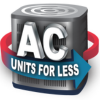What Does a Thermostat Do?
A thermostat is a device that manages the temperature in your home by regulating your HVAC system. It monitors the room’s temperature and sends signals to your heating or cooling system to turn on or off to achieve the set temperature.
Signs Your Thermostat Might Be Faulty
If your thermostat is malfunctioning, you might notice:
- Inconsistent Temperatures: Your home’s actual temperature doesn’t match what the thermostat is set to.
- No Response: Adjusting the thermostat doesn’t change the operation of your HVAC system.
- High Energy Bills: A faulty thermostat can cause your system to run more than necessary, increasing energy usage.
If you experience any of these issues, it might be time to check or replace your thermostat.
Common Problems with Thermostats
Several factors can cause a thermostat to fail:
- Dust and Dirt: Accumulated debris can interfere with its operation.
- Loose Wiring: Over time, wires may loosen, causing intermittent problems.
- Dead Batteries: Many thermostats rely on batteries, and dead ones can prevent proper function.
- Outdated Software: For smart thermostats, not keeping the software updated can lead to problems.
Troubleshooting Your Thermostat
Before calling a professional, try these troubleshooting steps:
- Replace the Batteries: If your thermostat uses batteries, start by replacing them.
- Clean the Thermostat: Open the cover and gently clean the inside to remove any dust.
- Check the Wiring: Make sure all wires are securely connected and not corroded.
- Verify the Settings: Ensure the thermostat is on the correct mode (heat or cool) and set to the desired temperature.
When to Consider Replacing Your Thermostat
If your thermostat can’t be repaired, replacing it might be the best solution. Consider these factors when choosing a new thermostat:
- Compatibility: Ensure it works with your HVAC system.
- Programmable vs. Non-Programmable: Programmable thermostats can save energy by adjusting the temperature when you're not home.
- Smart Features: Smart thermostats offer features like remote control, learning your preferences, and integration with smart home systems.
- Voltage: Make sure the new thermostat matches your system’s voltage requirements.
How to Replace a Thermostat
Replacing a thermostat is straightforward if you follow these steps:
- Turn Off Power: Disconnect power to your HVAC system to avoid accidents.
- Remove the Old Thermostat: Carefully disconnect the wiring and remove the thermostat from the wall.
- Install the New Thermostat: Connect the wires to the appropriate terminals on the new thermostat and mount it on the wall.
- Restore Power: Turn the power back on and test the new thermostat to ensure it works properly.
Cost of Replacing a Thermostat
The cost of a new thermostat varies depending on its type and features:
- Basic Thermostats: $20 to $80
- Programmable Thermostats: $50 to $150
- Smart Thermostats: $100 to $300
Labor costs for installation generally range from $50 to $150, depending on the job's complexity and your location.


